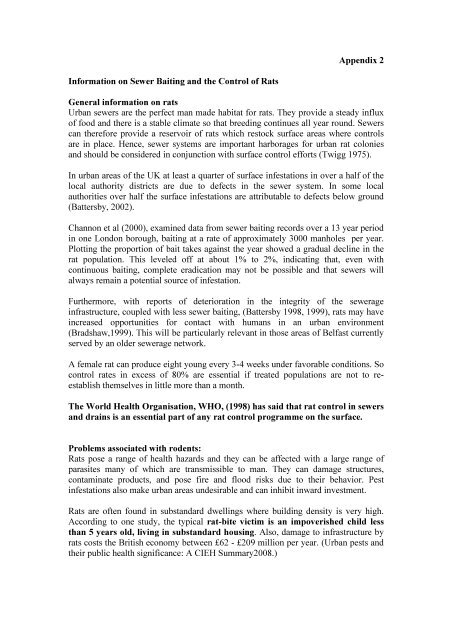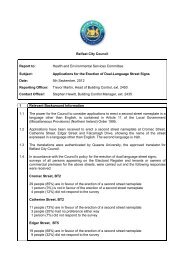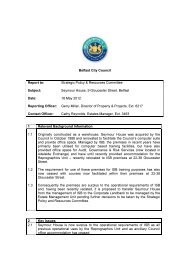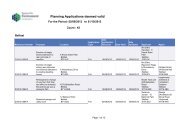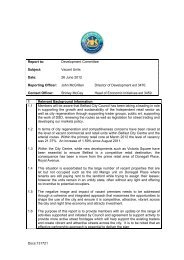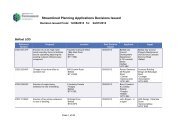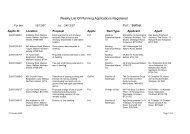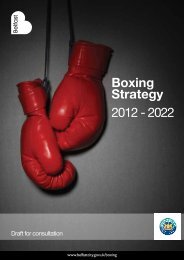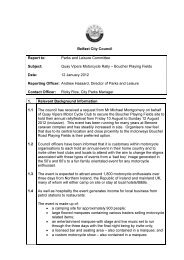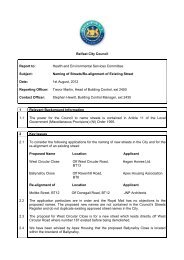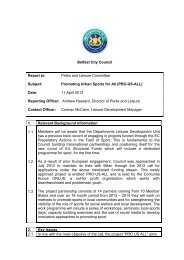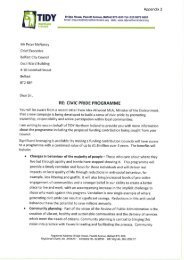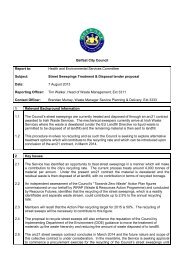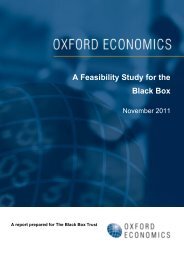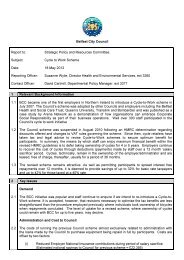Appendix 2 Information on Sewer Baiting and the Control of Rats ...
Appendix 2 Information on Sewer Baiting and the Control of Rats ...
Appendix 2 Information on Sewer Baiting and the Control of Rats ...
You also want an ePaper? Increase the reach of your titles
YUMPU automatically turns print PDFs into web optimized ePapers that Google loves.
<str<strong>on</strong>g>Appendix</str<strong>on</strong>g> 2<str<strong>on</strong>g>Informati<strong>on</strong></str<strong>on</strong>g> <strong>on</strong> <strong>Sewer</strong> <strong>Baiting</strong> <strong>and</strong> <strong>the</strong> C<strong>on</strong>trol <strong>of</strong> <strong>Rats</strong>General informati<strong>on</strong> <strong>on</strong> ratsUrban sewers are <strong>the</strong> perfect man made habitat for rats. They provide a steady influx<strong>of</strong> food <strong>and</strong> <strong>the</strong>re is a stable climate so that breeding c<strong>on</strong>tinues all year round. <strong>Sewer</strong>scan <strong>the</strong>refore provide a reservoir <strong>of</strong> rats which restock surface areas where c<strong>on</strong>trolsare in place. Hence, sewer systems are important harborages for urban rat col<strong>on</strong>ies<strong>and</strong> should be c<strong>on</strong>sidered in c<strong>on</strong>juncti<strong>on</strong> with surface c<strong>on</strong>trol efforts (Twigg 1975).In urban areas <strong>of</strong> <strong>the</strong> UK at least a quarter <strong>of</strong> surface infestati<strong>on</strong>s in over a half <strong>of</strong> <strong>the</strong>local authority districts are due to defects in <strong>the</strong> sewer system. In some localauthorities over half <strong>the</strong> surface infestati<strong>on</strong>s are attributable to defects below ground(Battersby, 2002).Chann<strong>on</strong> et al (2000), examined data from sewer baiting records over a 13 year periodin <strong>on</strong>e L<strong>on</strong>d<strong>on</strong> borough, baiting at a rate <strong>of</strong> approximately 3000 manholes per year.Plotting <strong>the</strong> proporti<strong>on</strong> <strong>of</strong> bait takes against <strong>the</strong> year showed a gradual decline in <strong>the</strong>rat populati<strong>on</strong>. This leveled <strong>of</strong>f at about 1% to 2%, indicating that, even withc<strong>on</strong>tinuous baiting, complete eradicati<strong>on</strong> may not be possible <strong>and</strong> that sewers willalways remain a potential source <strong>of</strong> infestati<strong>on</strong>.Fur<strong>the</strong>rmore, with reports <strong>of</strong> deteriorati<strong>on</strong> in <strong>the</strong> integrity <strong>of</strong> <strong>the</strong> sewerageinfrastructure, coupled with less sewer baiting, (Battersby 1998, 1999), rats may haveincreased opportunities for c<strong>on</strong>tact with humans in an urban envir<strong>on</strong>ment(Bradshaw,1999). This will be particularly relevant in those areas <strong>of</strong> Belfast currentlyserved by an older sewerage network.A female rat can produce eight young every 3-4 weeks under favorable c<strong>on</strong>diti<strong>on</strong>s. Soc<strong>on</strong>trol rates in excess <strong>of</strong> 80% are essential if treated populati<strong>on</strong>s are not to reestablish<strong>the</strong>mselves in little more than a m<strong>on</strong>th.The World Health Organisati<strong>on</strong>, WHO, (1998) has said that rat c<strong>on</strong>trol in sewers<strong>and</strong> drains is an essential part <strong>of</strong> any rat c<strong>on</strong>trol programme <strong>on</strong> <strong>the</strong> surface.Problems associated with rodents:<strong>Rats</strong> pose a range <strong>of</strong> health hazards <strong>and</strong> <strong>the</strong>y can be affected with a large range <strong>of</strong>parasites many <strong>of</strong> which are transmissible to man. They can damage structures,c<strong>on</strong>taminate products, <strong>and</strong> pose fire <strong>and</strong> flood risks due to <strong>the</strong>ir behavior. Pestinfestati<strong>on</strong>s also make urban areas undesirable <strong>and</strong> can inhibit inward investment.<strong>Rats</strong> are <strong>of</strong>ten found in subst<strong>and</strong>ard dwellings where building density is very high.According to <strong>on</strong>e study, <strong>the</strong> typical rat-bite victim is an impoverished child lessthan 5 years old, living in subst<strong>and</strong>ard housing. Also, damage to infrastructure byrats costs <strong>the</strong> British ec<strong>on</strong>omy between £62 - £209 milli<strong>on</strong> per year. (Urban pests <strong>and</strong><strong>the</strong>ir public health significance: A CIEH Summary2008.)
Nati<strong>on</strong>al Rodent Survey(These surveys involve resp<strong>on</strong>ses from local authorities in <strong>the</strong> UK)The Nati<strong>on</strong>al Rodent Survey 2002 suggested that <strong>the</strong>re was a 29% increase in brownrats between 1998 <strong>and</strong> 2002. One <strong>of</strong> <strong>the</strong> possible reas<strong>on</strong>s put forward as to why <strong>the</strong>rodent populati<strong>on</strong>s were growing was due to a reducti<strong>on</strong> in funding by <strong>the</strong> privatizedwater authorities. This has meant that routine sewer surveys <strong>and</strong> treatments have beencurtailed.The Nati<strong>on</strong>al Rodent Survey 2007/2008 found that brown rats c<strong>on</strong>tinue to be aproblem. The number <strong>of</strong> brown rat treatments were found to be over 378,000, up by44% <strong>on</strong> <strong>the</strong> previous year, with like-for-like treatment levels up more than 15%. Thesurge in rodent problems across <strong>the</strong> UK was traced back to a failure to get <strong>on</strong> top <strong>of</strong>populati<strong>on</strong>s <strong>the</strong> previous year. Excepti<strong>on</strong>ally mild c<strong>on</strong>diti<strong>on</strong>s through <strong>the</strong> 2006/2007winter meant rats were much less evident than usual in <strong>and</strong> around buildings.Exacerbated by <strong>the</strong> decrease in rodent c<strong>on</strong>trol in many areas this led to a markeddecline in both complaints <strong>and</strong> treatments. The populati<strong>on</strong> <strong>of</strong> rats increased greatly<strong>and</strong> this led to a surge <strong>of</strong> complaints <strong>and</strong> treatments with <strong>the</strong> colder autumn wea<strong>the</strong>r in2007.Under half <strong>of</strong> <strong>the</strong> recorded treatments took place in <strong>the</strong> summer <strong>and</strong> just over half in<strong>the</strong> winter. Mainly as a result <strong>of</strong> <strong>the</strong> very much higher levels <strong>of</strong> winter treatment, thisrepresents a clear change from <strong>the</strong> previous year when over 60% <strong>of</strong> rat treatmentswere in <strong>the</strong> summerThe Nati<strong>on</strong>al Rodent Survey 2009/2010 states that local authority ec<strong>on</strong>omies arealready threatening public health. Their benchmark annual report shows <strong>the</strong> largestyearly fall in recorded local authority rat treatments since <strong>the</strong> survey was instituted in1999. At <strong>the</strong> same time, it reveals that much <strong>of</strong> this decline results from changes incharging practice ra<strong>the</strong>r than any decline in infestati<strong>on</strong> levels. On a like-for-like basis<strong>the</strong> latest NPTA survey shows nati<strong>on</strong>al brown rat treatments were down by 19%, with<strong>the</strong> notable excepti<strong>on</strong> <strong>of</strong> Nor<strong>the</strong>rn Irel<strong>and</strong>.Rat activity/sewer baiting in Belfast<strong>Sewer</strong> baiting treatments in Belfast increased from 16542 in 2008/09 to 17557 in2009/10, (an increase <strong>of</strong> 6%), <strong>and</strong> <strong>the</strong> rat complaints dropped by almost 4%.Over <strong>the</strong> last 30 years <strong>the</strong> levels <strong>of</strong> rat complaints has increased, with most problemsarising in areas <strong>of</strong> deprivati<strong>on</strong>.O<strong>the</strong>r research/evidenceIt is <strong>the</strong> experience <strong>of</strong> local authorities such as Oldham MBC <strong>and</strong> Kinst<strong>on</strong> up<strong>on</strong> HullCC, which have undertaken careful m<strong>on</strong>itoring <strong>of</strong> rat activity, that above groundinfestati<strong>on</strong>s are reduced with proactive baiting, in <strong>the</strong> latter case using <strong>the</strong> pulsedbaiting method (CIHE <strong>Sewer</strong> baiting <strong>and</strong> <strong>the</strong> c<strong>on</strong>trol <strong>of</strong> rats 2003).
Thames Water staff <strong>and</strong> a group <strong>of</strong> EHOs have drawn up <strong>the</strong> L<strong>on</strong>d<strong>on</strong> <strong>Sewer</strong> <strong>Baiting</strong>Protocol. L<strong>on</strong>d<strong>on</strong> divides into three sectors <strong>and</strong> each sector identifies rodent hotspotsfor acti<strong>on</strong>. Evidence showed hotspots were coming under c<strong>on</strong>trol <strong>and</strong> <strong>on</strong>e such areawas Walthamstow High Street, well known for its street market <strong>and</strong> its prevalence <strong>of</strong>rats. A vagrant died in <strong>the</strong> town square <strong>and</strong>, when his body was found several weekslater, it had partly been eaten by rats. Now <strong>the</strong> high street is almost rat free. (CIEHWar <strong>on</strong> <strong>Rats</strong>, 1 st July 2011)Paul Chars<strong>on</strong>, Public Protecti<strong>on</strong> <strong>and</strong> licensing manager with West Lancashire BC, hasoutlined <strong>the</strong>ir pro-active baiting programme. They m<strong>on</strong>itor rat activity detectedduring <strong>the</strong>ir baiting programme <strong>and</strong> adjust <strong>the</strong>ir future programmes accordingly,taking into account <strong>the</strong>ir findings. They report approximately a 12% decrease inrodent activity in <strong>the</strong> sewers since 2006.CIEH –Positi<strong>on</strong> statement <strong>on</strong> sewer baiting- Nov 2003CIEH believes that local authorities should include within <strong>the</strong>ir sewer baitingstrategies an element <strong>of</strong> proactive sewer baiting for those parts <strong>of</strong> local authority areaswhere this approach is most appropriate.They encourage <strong>the</strong> development <strong>of</strong> joint strategies between local authorities <strong>and</strong>water companies for sewer baiting <strong>and</strong> <strong>the</strong> c<strong>on</strong>trol <strong>of</strong> rodent populati<strong>on</strong>s.CIEH is c<strong>on</strong>cerned that rat c<strong>on</strong>trol in sewers generally is inadequate <strong>and</strong> under funded<strong>and</strong> this failure is leading to an increased populati<strong>on</strong> above ground which localauthorities will have to deal with out <strong>of</strong> <strong>the</strong>ir limited budgets. Token <strong>on</strong>e-<strong>of</strong>fpois<strong>on</strong>ing in a sewer system will kill some rats. However, even when a populati<strong>on</strong> hasbeen reduced to a very small percentage <strong>of</strong> that originally in place, recovery to <strong>the</strong>original number can still occur with six m<strong>on</strong>ths.CIEH believes that public pest management is a job more suited to local authoritiesthan to private companies because pest management goes fur<strong>the</strong>r than simple pestc<strong>on</strong>trol. Local knowledge <strong>and</strong> records within a local authority can help identify thoseareas <strong>of</strong> a city where <strong>the</strong> sewers c<strong>on</strong>tinue or are likely to c<strong>on</strong>tain larger populati<strong>on</strong>s <strong>of</strong>rats. Proactive baiting can <strong>the</strong>refore still allow for <strong>the</strong> targeting <strong>of</strong> resources, as wellas helping to prevent movement <strong>of</strong> <strong>the</strong> rats through <strong>the</strong> sewer catchment area or out <strong>of</strong>sewers..
Lisburn5 rats complaintsx1004.5rat complaints per1000 people4popln x1000003.532.521.510.50Belfast10987rat complaints per1000 peoplecomplaints X1000popln x100000<strong>Rats</strong>65432101994/951996/971998/992000/012002/032004/052006/072008/092010/201119741976197819801982198419861988/891990/911992/93


